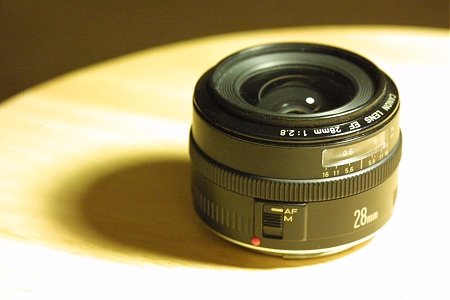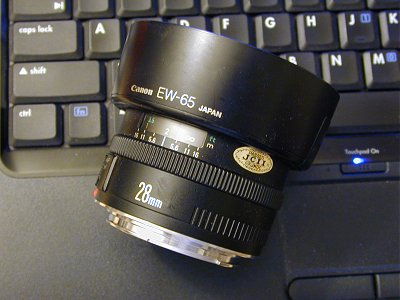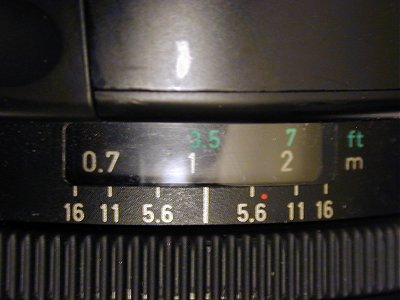Canon EF 28mm f/2.8 Lens
It's unfortunate that the Canon EF 28mm f/2.8 lens does not stand out in the EF lens line-up. It's one of those lenses that few people appreciate. When buying new lenses, the consumers tend to look at the more convenient zoom lenses. The professionals can afford to buy the L-series zoom with constant aperture. But the Canon EF 28mm f/2.8 lens is actually a gem for the advance amateur photographers.

Several reasons make this lens a gem: 1) It is inexpensive, quite affordable even for the typical consumer; 2) It has a large aperture; 3) It has a non-rotating front; 4) It has DOF marks; 5) It has a metal lens mount. If you are already an advanced amateur or a professional photographer, then these five reasons are self-explanatory and yon can skip the rest of the article. But if you are on the path to become one, then read on to see why you shouldn't overlook this lens.
I got the Canon EF 28mm f/2.8 lens used for approximately 125 dollars. A brand new version costs $170 on the market today. At these prices this lens is only slightly more expensive than the cheapest consumer-grade lenses, making this lens a bargain for almost anyone serious about photography.
This lens has an f/2.8 aperture, which is extremely rare on inexpensive lenses. An f/2.8 aperture has a relative large diameter, which has the ability to capture more light in relatively the same time frame. You'll be able to use this lens in low-light environments, such as in a classy dining restaurant without destroying the mood with electronic flashes. In addition, the large aperture will help reduce the depth-of-field (DOF) for this wide-angle 28mm lens. With the ability to shoot photographs with less depth-of-field, you can introduce more blurred effect in your picture to help your audience focus on what's important.
Although the 28mm f/2.8 lens is small and compact, it is relatively heavy for its size. Most of this weight is contributed by its metal lens mount, much like other high-quality EF lenses. The metal lens mount help prevent wear and tear failures. It is a highly desirable feature unless you are trying to shave weight for a long expedition on foot.
The non-rotating front on the Canon EF 28mm f/2.8 is a real plus. When you use rotary filters--such as circular polarizer, star, graduated, etc.--you won't have to constantly adjust your fitter after every focus. However, the focus element does extend and retract, at the front of the lens. The front focus element has a 52mm filter thread, the smallest filter diameter you'll ever find on any EF lens. The lens also comes with a front and rear lens caps.
You can also get an optional EW-65 lens hood. The EW-65 lens hood is covered, on the inside, in felt to absorb all light and prevent flares from reflection off the hood. The lens has a special lens hood track for the lens hood to clip on. The track is on the main lens barrel and not on the front focus element, so it does not extend or retract with the front of the lens. Because the track goes all the way around the lens and the lens hood is not flower-shaped, you can rotate the lens hood around the lens at will. The lack of a lock down, like on a bayonet hood mount, makes the lens hood feel flimsy when installed. Even so, I feel every lens should have a lens hood for protection (see my article on "Why I always use a lens hood") and for reducing flare.

The Canon 28mm f/2.8 lens uses micro-motor for auto-focusing. It is noisy and whiney much like older Canon consumer lenses. One professional feature that pre-dates USM is that when the lens is switched to AF mode the manual focusing ring is disengaged; you can rotate it as much as you want without effecting focus.
The focus distance window has DOF markings. Because DOF changes at different aperture, the focus distance window has markings for several f-numbers: f/5.6, f/11, and f/16. When focus is achieved, the DOF markings show the range at which objects are in focus. Using the picture below as an example, the DOF for f/11 starts at ~0.7 meters and ends at ~2 meters.

The focus distance window also has marking for infrared focus. The infrared marking is a simple red dot. When you use infrared film or sensor, focus as normal. Then when you are ready to shoot, rotate the focus ring so that the focus distance aligns with the red mark. Finally, snap away.
With-all these feature, the Canon 28mm f/2.8 lens is adequate for most professional needs. It really shines for the advanced amateur photographers. But if you are a photography enthusiast, it not a bad idea to start with this lens and learn the tool of the trade. I guarantee you that after practicing your skills with this lens, you will never look at consumer and professional lenses in the same way again.
Related Links
$10000-above
$5000-$9999
$2000-$4999
$1000-$1999
$500-$999
$200-$499
$100-$199
$50-$99
$25-$49
$0-$24
Gift Certificate

